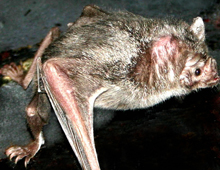Description: Most Common vampire bats have a small, circular, compact and muscular body that is varying shades of gray above and lighter gray underneath. The short, fine fur varies in length and attributes to a rather disheveled look. They have fang-like incisors and a long, pointed pink tongue. Two projecting, large, sharp upper incisors are joined at the bases by impressive canines. Only the canines are pointed and sharp on the lower jaw. The small peg-like front teeth used to grasp their prey are widely spaced so the tongue can lap the blood. The vampire bat has fewer teeth than other bats. The short neck and stub nose gives the face a “bulldog” appearance. The tail is absent with only a narrow membrane connecting the vampire’s long hind legs to the rump. The rather large dark eyes are set low on the face. The ears are pointed with a triangular-shaped flap that may assist in echolocation. A deep fold in the jutting lower lip gives the appearance that the lip is split. The long thumb on the edge of the forelimb is longer than the entire hind foot. With its three sole- like pads, it serves as a front foot, allowing the vampire bat to run silently on all fours.
Size: The length of the Common vampire bat is 2.8 – 3.5 inches (7 – 9 cm); wingspan is 7-8 inches (18 – 20 cm) and common weight is 1.8 -2 ounces (51 – 57 gr).
Behavior: During the day, the nocturnal vampire bat sleeps in places with total darkness, such as crevices or caves, where it hangs upside down. It spends 80% of its time sleeping or resting. About two hours each day is spent grooming each other and feeding regurgitated blood to their roost mates (when unable to find their own food). This sharing of food usually occurs between females and young bats. Vampire bats generally live in colonies of 20-100 individuals. The Common vampire bat is the most agile of all bats. It can fly, climb vertical walls, run, jump, hop quadrupedally and fling itself upward for flight – which is necessary for stalking and attacking its prey. Vampire bats do not usually alight on their victim, but land close by, walk to their prey and climb to the appropriate meal site.
Diet: It feeds exclusively on the blood of other vertebrates. The teeth slice into the flesh, making a 0.12 inch (0.3 cm) incision that is evidently rather painless, as the sleeping victim seldom awakens. It injects saliva that contains an anticoagulant chemical. Opening the wound and eating usually takes about 20 minutes. Two channels, located on the underside of the tongue, draw blood from the prey (like drinking through a straw). As the blood begins to flow, the bat sips and licks the blood, normally approximately 2/3 of an ounce (18.8 gr) or about 40-60% of its weight. Some bats will eat so much that they are unable to fly until some of the blood has been digested. However, since only red blood cells are needed, the digestive system quickly converts the plasma to urine, eliminating extra weight while eating.
Senses: Even though vampire bats are nocturnal, they have good vision and a well-developed sense of smell which helps select prey and recognize roost mates. The heat-sensing pits around the nose help the bat select warm body parts with a rich blood supply close to the surface of the skin.
A good sense of touch warns the bat if prey is awakening from sleep. Hearing is the most important and accurate sense of the vampire bat. Vampires, like most bats, navigate by echolocation. High frequency sounds are sent out that reflect off objects, with bat listening for the echoes in order to locate their prey. These bat sounds are too high to be heard by humans.
Communication: Vampire bats use a low frequency for social interactions and a higher frequency for echolocation.
Reproduction: Common vampire bats are sexually mature at approximately nine months of age. Most females normally have one pregnancy each year. A gestation period of about seven months, usually results in a single young, but occasionally there are twins. The well-developed newborns weigh between 0.18 – 0.25 ounce (5 – 7 gr) at birth. After one month of feeding on milk from the mother, the mother regurgitates blood for the young until about four months of age, at which time they begin to hunt with their mother. Growth is normally complete at about five months of age.
Habitat/range: Vampire bats are found in mines, caves, hollow trees or rock crevices throughout Mexico, Central America to northern Argentina and Chile.
Status: IUCN – Least Concern (LC).
Additional information:
Bats are the only mammals that can fly; vampire bats are the only mammals that feed entirely on blood.
The saliva of the vampire bat contains an anti- coagulant which keeps the blood vessels from contracting. Known as Draculin, the anti- coagulant keeps the wound bleeding freely for up to 30 minutes. The anticoagulant in vampire bats is twenty times stronger than any other known clotting agent. A normal wound the size of a vampire bat bite, would usually cease bleeding in 1-2 minutes. Studies are being conducted to determine how this anticoagulant might help with serious human disorders like heart attacks and strokes. It is also believed the saliva may contain a numbing anesthetic to deaden the pain, thus keeping the host from being aware of the bite.
Because of their feeding habits, vampire bats are potential transmitters of a variety of diseases — the most noted being rabies. Any mammal, including man, can become infected by the bite of a rabid vampire bat. The usual victims are cattle and other vampire bats. The virus-containing saliva is passed onto other vampire bats when grooming, sharing regurgitated food or during social squabbles. Sudden removal of the vampire bat’s regular hosts can cause attacks on humans. Bites on humans are usually on the toes, noses and ear tips, however, incidences of humans contracting rabies from vampire bats are rare.



